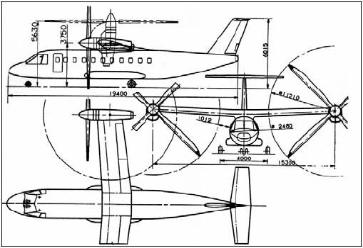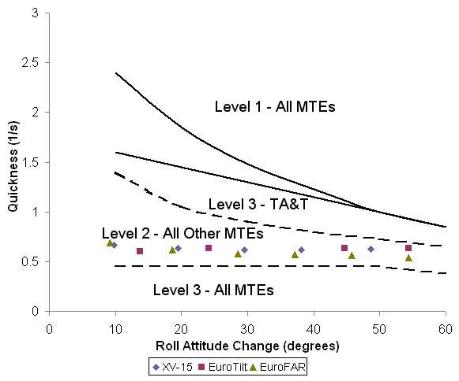HQTILT - Research Highlights
The EuroFAR simulation model
The simulation of the European Future Advanced Rotorcraft (EuroFAR), a large civil tilt rotor aircraft, has allowed comparisons to be made between differently sized aircraft, and the effect that this has on handling qualities.
EuroFAR was conceived by a European consortium in the early 1990s, as a 30 passenger, short range transport aircraft, with the benefit of its ability to hover at the start and end of the mission, and thus take off from and land in small areas.
The EuroFAR design remained on the drawing board however, as European attention switched to EuroTilt.
Tilt rotor handling qualities
The handling qualities of the three tilt rotor aircraft (XV-15, EuroTilt and EuroFAR) modelled at Liverpool have been assessed across the flight envelope, with comparisons made against criteria appropriate to the mode the aircraft is operating in - such as ADS-33E handling qualities requirements for operation in the helicopter mode (nacelles tilted to the vertical) and MIL-STD-1797A requirements for operation in the aeroplane mode (nacelles tilted to the horizontal). Additionally the aircraft have been flown in Liverpool's Flight Simulator to assess handling qualities in standard MTEs. Below are examples of the results.
One of the primary handling qualities requirements is the attitude quickness of an aircraft. Quickness is a measure of how rapidly a change in attitude (either pitch, roll or yaw) can be achieved. The figure below shows the roll attitude quickness of the three aircraft in the hover. Each aircraft has been assessed with any SCAS (stability and control augmentation system) functions disabled, so as to provide a fair comparison of the base performance of each aircraft. The results have been plotted against the ADS-33E roll attitude quickness requirements for target acquisition and tracking MTEs (marked as TA&T) and all other MTEs.
All aircraft have insufficient agility for target acquisition and tracking MTEs, although this is not surprising as this is not the designed role of the aircraft. For less aggressive MTEs, the roll quickness falls into the Level 2 region, which suggests that it is possible to complete these manoeuvres, albeit with compromises in performance, and with significantly increased pilot workload to compensate for the deficiencies of the aircraft.
